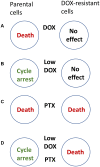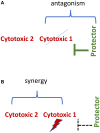Selective protection of normal cells from chemotherapy, while killing drug-resistant cancer cells
- PMID: 36913303
- PMCID: PMC10010629
- DOI: 10.18632/oncotarget.28382
Selective protection of normal cells from chemotherapy, while killing drug-resistant cancer cells
Abstract
Cancer therapy is limited by toxicity in normal cells and drug-resistance in cancer cells. Paradoxically, cancer resistance to certain therapies can be exploited for protection of normal cells, simultaneously enabling the selective killing of resistant cancer cells by using antagonistic drug combinations, which include cytotoxic and protective drugs. Depending on the mechanisms of drug-resistance in cancer cells, the protection of normal cells can be achieved with inhibitors of CDK4/6, caspases, Mdm2, mTOR, and mitogenic kinases. When normal cells are protected, the selectivity and potency of multi-drug combinations can be further enhanced by adding synergistic drugs, in theory, eliminating the deadliest cancer clones with minimal side effects. I also discuss how the recent success of Trilaciclib may foster similar approaches into clinical practice, how to mitigate systemic side effects of chemotherapy in patients with brain tumors and how to ensure that protective drugs would only protect normal cells (not cancer cells) in a particular patient.
Keywords: cyclotherapy; oncology; rapamycin; resistance; trilaciclib.
Conflict of interest statement
Author has no conflicts of interest to declare.
Figures






References
-
- He S, Roberts PJ, Sorrentino JA, Bisi JE, Storrie-White H, Tiessen RG, Makhuli KM, Wargin WA, Tadema H, van Hoogdalem EJ, Strum JC, Malik R, Sharpless NE. Transient CDK4/6 inhibition protects hematopoietic stem cells from chemotherapy-induced exhaustion. Sci Transl Med. 2017; 9:eaal3986. 10.1126/scitranslmed.aal3986. - DOI - PMC - PubMed
Publication types
MeSH terms
Substances
LinkOut - more resources
Full Text Sources
Medical
Research Materials
Miscellaneous

